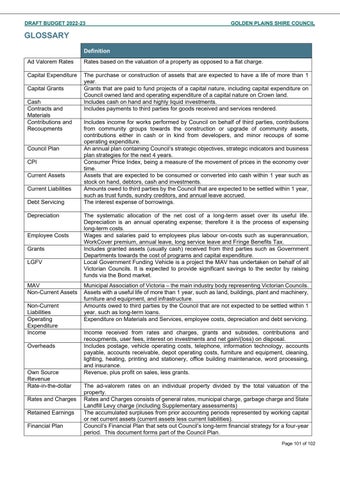DRAFT BUDGET 2022-23
GOLDEN PLAINS SHIRE COUNCIL
GLOSSARY Definition Ad Valorem Rates
Rates based on the valuation of a property as opposed to a flat charge.
Capital Expenditure
The purchase or construction of assets that are expected to have a life of more than 1 year. Grants that are paid to fund projects of a capital nature, including capital expenditure on Council owned land and operating expenditure of a capital nature on Crown land. Includes cash on hand and highly liquid investments. Includes payments to third parties for goods received and services rendered.
Capital Grants Cash Contracts and Materials Contributions and Recoupments Council Plan CPI Current Assets Current Liabilities Debt Servicing Depreciation Employee Costs Grants LGFV
MAV Non-Current Assets Non-Current Liabilities Operating Expenditure Income Overheads
Own Source Revenue Rate-in-the-dollar Rates and Charges Retained Earnings Financial Plan
Includes income for works performed by Council on behalf of third parties, contributions from community groups towards the construction or upgrade of community assets, contributions either in cash or in kind from developers, and minor recoups of some operating expenditure. An annual plan containing Council’s strategic objectives, strategic indicators and business plan strategies for the next 4 years. Consumer Price Index, being a measure of the movement of prices in the economy over time. Assets that are expected to be consumed or converted into cash within 1 year such as stock on hand, debtors, cash and investments. Amounts owed to third parties by the Council that are expected to be settled within 1 year, such as trust funds, sundry creditors, and annual leave accrued. The interest expense of borrowings. The systematic allocation of the net cost of a long-term asset over its useful life. Depreciation is an annual operating expense; therefore it is the process of expensing long-term costs. Wages and salaries paid to employees plus labour on-costs such as superannuation, WorkCover premium, annual leave, long service leave and Fringe Benefits Tax. Includes granted assets (usually cash) received from third parties such as Government Departments towards the cost of programs and capital expenditure. Local Government Funding Vehicle is a project the MAV has undertaken on behalf of all Victorian Councils. It is expected to provide significant savings to the sector by raising funds via the Bond market. Municipal Association of Victoria – the main industry body representing Victorian Councils. Assets with a useful life of more than 1 year, such as land, buildings, plant and machinery, furniture and equipment, and infrastructure. Amounts owed to third parties by the Council that are not expected to be settled within 1 year, such as long-term loans. Expenditure on Materials and Services, employee costs, depreciation and debt servicing. Income received from rates and charges, grants and subsides, contributions and recoupments, user fees, interest on investments and net gain/(loss) on disposal. Includes postage, vehicle operating costs, telephone, information technology, accounts payable, accounts receivable, depot operating costs, furniture and equipment, cleaning, lighting, heating, printing and stationery, office building maintenance, word processing, and insurance. Revenue, plus profit on sales, less grants. The ad-valorem rates on an individual property divided by the total valuation of the property. Rates and Charges consists of general rates, municipal charge, garbage charge and State Landfill Levy charge (including Supplementary assessments) The accumulated surpluses from prior accounting periods represented by working capital or net current assets (current assets less current liabilities). Council’s Financial Plan that sets out Council’s long-term financial strategy for a four-year period. This document forms part of the Council Plan. Page 101 of 102



